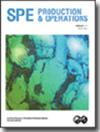Detecting Phase-Inversion Region of Surfactant-Stabilized Oil/Water Emulsions Using Differential Dielectric Sensors
IF 1.3
4区 工程技术
Q2 ENGINEERING, PETROLEUM
引用次数: 1
Abstract
An experimental and theoretical investigation of surfactant-stabilized oil/water emulsion characteristics was carried out under water sweep (WS) and oil sweep (OS) conditions. Both hydrophilic and hydrophobic surfactants were used, with concentrations less than and more than the critical micelle concentration (CMC). Experimental data were acquired for detection of the phase-inversion region, which was measured simultaneously by several independent methods. These include a circular differential dielectric sensor (C-DDS), a rectangular differential dielectric sensor (R-DDS) (both sensors accurately detect the phase-inversion region), a pressure transducer, and a mass flowmeter. The addition of an emulsifier surfactant to an oil/water mixture generated a stable emulsion, which resulted in a phase-inversion delay. For water-continuous to oil-continuous flow, a hydrophilic surfactant was a better emulsifier, while for oil-continuous to water-continuous flow, a hydrophobic surfactant was a better emulsifier for creating more stable emulsions. The surfactant/oil/water emulsion resulted in an increase of the dispersed-phase volume fraction required for phase inversion, as compared to the case of oil/water dispersions without surfactant. For emulsions with surfactant concentrations above CMC, the presence of micelles contributed to further delay of the phase inversion, as compared to those with surfactant concentrations below CMC. The phase-inversion region exhibits a hysteresis between the OS and WS runs, below CMC and above CMC, which was due to the difference in droplet sizes caused by different breakup and coalescence processes for oil-continuous and water-continuous flow. This research shows that the DDS is an efficient instrumentation that can be used to detect the region where the emulsion phase inversion is expected to occur. Moreover, the experimental results and the pertinent analysis and discussion provide useful insights for a more informed design of surface facilities (including emulsion separators) in oil and gas production operations.用差分介质传感器检测表面活性剂稳定油/水乳液的相反转区
在水驱(WS)和油驱(OS)条件下,对表面活性剂稳定的油水乳液特性进行了实验和理论研究。使用亲水性和疏水性表面活性剂,其浓度小于或大于临界胶束浓度(CMC)。通过几种独立的方法同时测量相位反转区域,获得了用于检测相位反转区域的实验数据。其中包括圆形差分介电传感器(C-DDS)、矩形差分介电感知器(R-DDS)(两个传感器都能精确检测反相区域)、压力传感器和质量流量计。向油/水混合物中添加乳化剂-表面活性剂产生稳定的乳液,这导致相转化延迟。对于水-油连续流动,亲水性表面活性剂是更好的乳化剂,而对于油-水连续流动,疏水性表面活性素是更好的乳化剂,可以产生更稳定的乳液。与不含表面活性剂的油/水分散体的情况相比,表面活性剂/油/水乳液导致相转化所需的分散相体积分数增加。对于表面活性剂浓度高于CMC的乳液,与表面活性剂含量低于CMC的乳液相比,胶束的存在有助于进一步延迟相转化。相反转区域在低于CMC和高于CMC的OS和WS运行之间表现出滞后,这是由于油连续流和水连续流的不同破碎和聚结过程引起的液滴尺寸的差异。这项研究表明,DDS是一种有效的仪器,可用于检测预计发生乳液相反转的区域。此外,实验结果以及相关的分析和讨论为石油和天然气生产操作中更明智的地面设施(包括乳液分离器)设计提供了有用的见解。
本文章由计算机程序翻译,如有差异,请以英文原文为准。
求助全文
约1分钟内获得全文
求助全文
来源期刊

Spe Production & Operations
工程技术-工程:石油
CiteScore
3.70
自引率
8.30%
发文量
54
审稿时长
3 months
期刊介绍:
SPE Production & Operations includes papers on production operations, artificial lift, downhole equipment, formation damage control, multiphase flow, workovers, stimulation, facility design and operations, water treatment, project management, construction methods and equipment, and related PFC systems and emerging technologies.
 求助内容:
求助内容: 应助结果提醒方式:
应助结果提醒方式:


